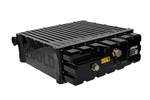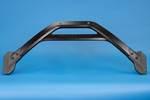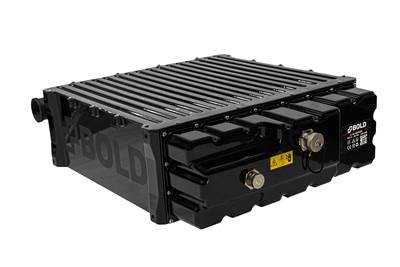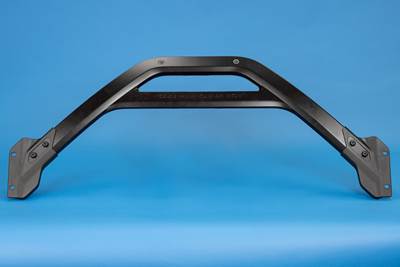The vehicle’s carbon fiber-reinforced polymer (CFRP) body at the assembly stage in Aptera’s facility. The body in carbon (BinC) structural approach uses carbon fiber sheet molding compound (CF-SMC) techniques developed in collaboration with CPC Group to achieve high strength-to-weight ratios and scalability in production.
Aptera (Carlsbad, U.S.) is a California startup developing a solar electric vehicle (sEV) that offers a 1,000-mile range and the ability to avoid plugging in thanks to 700 watts of continuous charging power provided by its solar panels while driving or parked. However, this performance demands a new ultimate in efficiency — both in aerodynamic shape and light weight. Composites have helped to achieve both, comprising the vehicle’s body in carbon (fiber), or BinC, which reportedly can be recycled up to five times for an ultra-low CO2 life cycle cost. This also aligns with Aptera’s drive for sustainability.
Working alongside composite parts supplier CPC Group (Modena, Italy), Aptera’s BinC is composed of only six main parts — the tub, roll bar, two roof panels and two side panels — all made from carbon fiber sheet molding compound (CF-SMC) combined with glass fiber sheet molding compound (GF-SMC). As the company leads up to production-intent builds (anticipated for 2024), CW’s contributing writer, Stewart Mitchell, touched base with Aptera co-founder, Steve Fambro, to talk more about Aptera’s use of composites, its work with CPC, the sEV’s design and manufacturing process, Aptera’s goals and targetsfor production and more.
CompositesWorld (CW): Can you explain your background and approach to incorporating carbon fiber composites into the vehicle’s structure in Aptera, as well as the key benefits over the traditional framework that you may have considered?
Steve Fambro (SF): The story of how I got involved with composites goes back to when I first contemplated starting my company, which was around 2005. At that time, I was considering building a vehicle with aerodynamic shapes, and I knew that to achieve an extraordinary range with an electric vehicle (EV), it would have to be very lightweight and have a low drag coefficient or drag product. This is when I started exploring the use of composites, because I was a private pilot and had experience with composite aircraft, specifically Diamond Aircraft.
Initially, I thought about building something inspired by a Burt Rutan design, Long-EZ, which was my first introduction to structural composites. I read everything I could about Burt Rutan, and bought his booklets and training videos on how to make composite parts. I started by making little hand-laid beams with foam core, Divinycell, unidirectional and bidirectional fibers. Rutan’s handbooks had a little test that people could do to become more comfortable with composites — you build these beams, support them double-ended and stand on them. Being able to support my bodyweight with these lightweight beams was impressive and gave me the confidence to further explore composites.
I continued my journey by buying blueprints of experimental aircraft and learning everything I could about composite materials. I even went back to the de Havilland Mosquito, which was the first composite aircraft. I learned about using end grain balsa as a core material and explored hardpoints. I learned how to apply a load in a composite panel — whether it’s applied along the face sheet or orthogonal to it, and what kind of material would be needed for the hardpoint. De Havilland did it differently by using round circles of hardwood to bolt on those loads.
As I was learning these things, it was right around the time when I met Chris Anthony, the other co-founder of Aptera. Chris had a boat company, Epic Boats, and he was using vacuum resin-infused bottoms to make these lightweight sandwich core boats. This was a wakeboard boat, a very specific kind of pleasure watercraft that had a pump system to bring in water as a ballast to increase its weight and make an extra-large wake. This particular one could be towed much more easily and used less energy to tow it thanks to its light weight; it could be towed with a small car.
Chris and I met through a common friend. I was having all my composite materials sent to the company he worked with, and a friend recognized the resins and stuff like that. She said, “Hey, I’ve got a friend who’s building this boat company. You guys should talk.” That’s how we met and how we began on this composites journey together.
Steve Fambro, co-founder of Aptera, who has driven the innovative use of SMC composites in the vehicle's design. Source (All Images) | Aptera
At the time, we had different ideas and approaches to how a composite car should be built. I wanted to use a bunch of flat faceted panels that would be CNC cut, and then bond them together to make a structure and put a simple aeroshell over it. Chris thought we should make as few parts as possible, and as long and as contiguous as possible, to make it stronger and lighter. We hired a composite expert to help adjudicate that, and he very quickly agreed with Chris.
We started building stuff like the section of the old, original Aptera, which was green Divinycell. This was all open mold vacuum resin infusion, a lightweight, high-performance structure. However, these structures required a lot of labor, not only to cut the cloth but also to lay it in the right orientation, prepare the mold and so on. There was no real way to automate the labor in resin infusion composite sandwich panels, none that we’d seen, at least.
When we started back in 2019, we were fully prepared to use this method because we thought 1,000-2,000 cars a year could be done by hand. Then, when we launched the concept, we got 1,000 orders for Aptera in the first week, and we realized that it was not possible to do it by hand. We would need thousands of employees to make it happen, the variability would be too high and it would result in hundreds of mold sets, which was not feasible.
In the early stages, we were still pushing the envelope and working with a local San Diego company with a UV cure resin. We made all the parts with this resin, which had a very fast cycle time. However, it was still not scalable, and that’s when we hired Akos Feher, our current VP of engineering, to go out and find us the best method to produce structures in these volumes. He introduced us to CPC Group (Moderna, Italy), and we were really impressed with the precision and quality of the parts they were able to produce. It was clear that their method was the best fit for our needs and would help us achieve the level of efficiency and consistency we were looking for. We quickly began to move forward with CPC as our manufacturing partner and have already achieved amazing results together.
CW: Where is the balance between refined body design and volume production?
SF: Internally [in Aptera] discussing the topic of composites, it was noted that the BMW i3 car was a good example to examine. However, upon closer inspection, we discovered that the i3 was already quite outdated, especially in 2019. This was evident from a Monroe teardown report, which is a detailed analysis of the car’s components, providing valuable insights into the car’s carbon fiber teardown and how it was assembled.
CPC has developed expertise in designing parts for this process, simulating and validating them in-house. We relied heavily on their expertise in selecting the right materials for our project.
Of particular interest were the composite parts made by Dieffenbacher for BMW. While the use of roll tape or custom blanks with different fiber orientation in a matrix was a valid way to make these parts, it still required a high cycle time and significant human touch. This made it challenging to scale up production for high-volume manufacturing.
Looking at BMW’s success in the marketplace, it was apparent that the i3 was considered a low-volume car that did not sell as well in the U.S., with annual sales of 10,000 to 11,000 units. However, this did not mean that BMW was incapable of making more; it simply required significant capitalization to set up a plant to produce these parts. This was a crucial barrier for the Aptera team, as we were unsure if we could raise the amount of money required for that level of production. Therefore, we needed to find an alternative method to produce the required parts, which led us to explore other options. CPC’s method of SMC body part fabrication was the right method that was more feasible for Aptera’s needs.
CW: Can you provide details regarding the specific types of fibers and resin systems used in the construction of the carbon [fiber] body? How were these materials selected and what factors were considered in qualifying their structural performance?
SF: In the Aptera project, our partner, CPC in Modena, played a significant role in the materials selected and what factors were considered in qualifying their structural performance. Working with them enabled us to take a leap forward in our experience level. Chris and I had previously worked with open mold resin infusion, but with CPC, we were able to work with closed CF-SMC, a more advanced process. CPC already has an existing business of producing these parts for various supercar manufacturers, mainstream OEMs and other white-label applications. They are highly integrated, making the tools, producing the parts and even assembling them into substructures or entire structures as white-label products for OEMs.
Over the past few years, CPC has developed expertise in designing parts for this process, simulating and validating them in-house. We relied heavily on their expertise in selecting the right materials for our project. At the time, CPC had a large but still minority ownership by Mitsubishi, specifically Mitsubishi Rayon or Mitsubishi Chemical. Last year, Mitsubishi completed the full acquisition of CPC, and while there is a transition of activities and staff, it will take place over a couple of years. For our specific product, CPC chose Mitsubishi products, and they use a proprietary resin matrix for the Aptera BinC. I can’t mention the exact formula, but it was chosen to minimize weight, maximize strength and ensure that the product is producible at the rate we need it to be.
CW: SMC removes orientation-based performance. Can you describe the process you used to define the features of the part? Could you provide some specific stiffness numbers for any of the panels, which would help readers understand the strength of these parts better?
An interior view of Aptera's composite chassis illustrates the scale and integration of the BinC parts. BinC is said to represent the largest parts CPC has ever produced in SMC.
SF: In our project, we did not provide specific metrics for every panel property. Instead, we focused on vehicle-level targets such as torsional and bending moments, resonance and frequency modes. We knew that SMC or CF-SMC would not produce a panel as light per unit strength as a sandwich core. However, our main goal was to have a clear way to simulate the material accurately.
Finite element analysis (FEA) was a huge part of the development process. My background is electrical engineering. FEA is similar in both electrical and physical domains, and it is sensitive to discontinuities at interfaces and material changes. Modeling materials helped us predict the failure point but not beyond that. However, the material we used is well-characterized, making it almost as simple to model as aluminum or steel. This material’s characterization is the result of R&D and intellectual property (IP) that CPC has developed. Our vehicle has a composite tub, roll structure inside the body and an aluminum subframe in the front and rear. To simulate crashes, the material needed to be perfectly understood and modifiable. The material is well understood in the software model, allowing us to trust the simulations. Although we may have given up some weight advantages compared to a sandwich construction with a foam core, we gained overall productivity and design robustness. We have a very good idea of how the vehicle will perform even before we conduct crash tests in real life.
CW: Is the material isotropic and exhibiting consistent fiber behavior in all directions?
SF: The process of creating these parts involves a great deal of precision and attention to detail. The fibers used in the manufacturing process must remain random and not become aligned or coagulate, which requires a great deal of expertise and experience. This is achieved through years of R&D, including mold design and simulation of the material flowing through the mold under pressure of 5,000 tons. The simulation must be precisely correlated with real-life behavior to ensure concordance, which is critical to the final product. All of this expertise and knowledge is already in place when you sign up with CPC, so there is no need to reinvent the wheel.
I discovered that the primary factor limiting the range of these EVs at highway speeds was drag. In fact, over half of the energy consumed by these vehicles was being used to push air out of the way.
CW: Has a novel manufacturing process been developed specifically to produce this product, or is it an evolution of an existing process that has been adapted for this purpose?
SF: Through collaboration with CPC and their partner companies, we were able to design and build the BinC using much of their understanding in under a year using a manufacturing process that leverages existing composite materials and simulation technology. We started with a basic design made from resin-infused parts, and with the knowledge of materials and power of simulation, we were able to rapidly iterate through design changes necessary to make the vehicle out of SMC. The result is a strong, durable and reliable structure that we can put into the manufacturing process and have it ready for production in just one year. This process is highly efficient and already being used for other high-volume customers, although it is not yet publicized. Through the ecosystem of suppliers in Italy that CPC works with, we have a streamlined process that saves time and likely billions of dollars in design costs.
CW: The integration of solar panels into the structure is a unique construction feature. How integrated are the solar panels in terms of structure? What were the specific technical challenges that had to be overcome to integrate the solar panels?
SF: The panel design for our vehicle presented several challenges, the most significant of which was the difference in coefficient of thermal expansion (CTE) between the different materials. To address this issue, we decided to use chemically strengthened glass materials for solar arrays with favorable CTEs that can match up with the BinC structure without the need for large gaps and seals. This design also provides a more aesthetic look and also ensures better aerodynamics.
Initially, we had considered embedding the solar panels within the composite panel itself. However, we faced several technical challenges, including the yellowing of the resin and the need for appropriate UV stabilization agents for bonding the cell surface chemistry. Therefore, we decided to keep the panels separate and removable for serviceability and opted for a structural design that can add strength to the vehicle. This also contributed to the decision to use the chosen materials for the solar panel to more closely align the CTEs of the two materials. This design not only ensures a robust and rugged panel but also facilitates repair and upgrades.
Although we have the option to structurally bond the panels to the composite, we chose to make them removable to enhance serviceability. This design is similar to how a windshield is removable from the frame of a vehicle.
Most of our IP is related to solar panel design and manufacturing, and we have gone off on the deep end in solar to make this happen. We had visions and had done experiments of embedding the solar in the composite panel itself, but the technical challenges were too significant to make that design viable for a road vehicle. However, we may consider such a design for airborne operations.
CW: Do solar panels, made structurally of glass, use new technology and material science? Is this a novel feature of the panels?
SF: I prefer not to divulge any further information on the panels as it may upset the solar design team. However, we have a business development team that is currently implementing our solar technology in various market segments. This technology offers value to a wide range of individuals beyond just users of the Aptera vehicle. Moreover, our polymer base system is ideal for applications where weight and cost are critical factors. On the other hand, for high-performance and durable applications, our glass-based technology is the way to go. It is a thin, chemically strengthened material that is incredibly robust and long-lasting.
CW: What it the interface between the solar panel and the body and how does it deal with CTE?
SF: The solar arrays are bonded to the front hood, dash or insert panel, roof and rear deck. They are attached using a bonding process that improves the structural rigidity and resilience of the vehicle. The rear deck, in particular, is a challenging component due to its size and may be the largest panel ever made in a single shot. However, all the components are bonded in a similar manner to create a closed section, like a D-channel, which enhances their overall strength and durability.
CW: Can you confirm if all the sections of the solar panel are uniform in shape or if they are specifically curved to fit different body elements? Are there any restrictions on the compatibility of certain parts with specific sections? For example, can part A only fit into section A, and is there a specific part that fits into section A and not others?
SF: The hood and roof of the vehicle have conformal 3D curved pieces that fit in only one direction and mimic the shape of the vehicle. This is the challenge for our IP, as we have to make the large panels conformal and build the cells without breaking them or causing microcracking that would lead to premature failure. This has been the focus of our work for the past few years, and we have successfully designed all the panels to be conformal to the vehicle’s surface, as intended in the CAD.
Detailed view of the Aptera's carbon fiber rear deck structure, designed for integration of proprietary solar panels. Here, detailed material science meets solar panel array engineering requirements, including thermal expansion and structural integrity..
The design of a solar car raises concerns about thermal expansion and the bonding between its components. The finish of the vehicle and the substructures that connect the base panels to the car’s frame must be taken into consideration in relation to the thermal expansion that occurs due to exposure to sunlight. The final structure is created through the bonding of the solar panels, but the bonding and the subframe also need to be considered, especially in relation to CTEs. The i3 teardown process revealed several complexities in the use of materials and the CTE of those materials. The i3 vehicle uses around 20 different structural adhesives with varying CTEs, depending on the materials being bonded. However, we have only one adhesive that we use, thanks to our high compatibility with CTE. We made sure to avoid using different adhesive formulas for different sections of insulation by revisiting the panel design and aligning the CTEs with the CF-SMC matrix.
CW: Because composites are known to be sensitive to UV, could you explain how this particular structure is able to withstand frequent exposure to direct sunlight?
SF: Our vehicle’s exterior surface, particularly on the top half, is primarily composed of glass solar panels, which provides excellent insulation. To protect the doors and sides, we use a 3M film wrap instead of painting the vehicle. This allows us to save on the cost of building a new paint shop, which can cost several hundred million dollars in the U.S., while also being better for the environment. The use of wraps is a cost-effective and reliable solution, providing robust performance and allowing for greater customization in color options. This approach eliminates the need to produce volatile chemicals and aerosols, which can be challenging to control.
CW: In the design of your vehicle, how much did you take into account the repairability strategy and the extension of the use phase of the vehicle? Specifically, you considered the number of bonding agents required, but have you also considered the skillsets and repair methods needed for those involved in vehicle repair, including any future partners? Additionally, was the CF-SMC structural design of the vehicle taken into consideration with respect to repairability?
SF: Our main goal was to provide customers with reassurances that in case of irreparable damage to the panel, it could be easily removed and replaced. We also wanted to create provisions for the future, as solar cells are constantly increasing in efficiency. This means that people may want to upgrade their panels to get better energy output with newer cell technology in the future. Although adhesive selection and repairability were important factors, it is difficult to enforce the use of the right adhesive in a repair, especially if some adhesives are inaccessible in some regions.
CW: The field of aerodynamics plays a crucial role in determining the behavior of this vehicle and its overall design, structure and performance. Can you share more about the origins of your aero profile and what inspired its design?
SF: In 2003-2004, before EVs were commercially available, I became interested in building an EV as a hobby. As I talked to people who had converted their cars to electric, I realized that most of them could only drive for 30-40 miles before needing a recharge. I was curious to understand why this was the case, so I used MATLAB to run some calculations. I discovered that the primary factor limiting the range of these EVs at highway speeds was drag. In fact, over half of the energy consumed by these vehicles was being used to push air out of the way. This struck me as wasteful, and I wondered why vehicle designers would knowingly create such inefficient designs.
I began to study low-drag vehicles and discovered the skin effect with the body and ground effects. These effects were minimized if the car was based on the principle of a teardrop-shape with a flat bottom. This can significantly reduce drag. By surrounding two people in a shape modeled after this effect, I believed we could create a vehicle that was much more energy-efficient than traditional designs. This inspired me to design my own low-drag vehicle, which ultimately became the basis for the Aptera vehicle we built. The Aptera vehicle draws heavily from concepts found in the aerospace industry and Formula racing car design, with particular attention paid to front suspension systems like the wishbone suspension, as well as the use of outboard wheels.
The concept faces opposing forces due to the need for a large, paneled structure on the solar side while still maintaining an aerodynamic shape with minimum drag. Most high-performance solar cars are effective, though they lack compartment space, making it uncomfortable for passengers to sit and look out. In things like the Solar Challenge, solar cars use low-drag bicycle wheels, rudimentary seats and feature small slots through the front of the car for the driver to peer through. Therefore, the challenge is to maximize volume to accommodate solar panels while maintaining a sleek and aerodynamic shape.
The BinC inner door panel structure has significant structural engineering requirements, including side impact performance and lightweighting.
At the Torino Automotive Museum, I saw a solar car for the first time in my life. It was displayed in a circular facility, in a hall showcasing future technologies. Among other interesting concepts, they had a Shell Eco Marathon car that looked like a coffin on wheels — incredibly small. The driver had to lie down in the car, facing a slit. I had always imagined these cars to be larger, but they are very small. Due to our larger aerodynamic design, we have a larger wetted area, which increases the skin drag. However, it also gives us plenty of surface area to install the solar panels.
CW: How did you analyze crash safety and the behavior of composites under compression, particularly high-speed compression? I am unsure of the specific regulations regarding crash viability for a certain volume of vehicles, but given the high number of orders received, I assume that full manufacturing, safety testing and homologation will be necessary. Can you provide information on how you have mapped out the crash safety and composite behavior in compression for this vehicle?
SF: Much of our vehicle design meets the standards for motorcycles in the U.S., but we have chosen to go beyond that and design to automotive standards for safety. Our vehicle has airbags and a combination of metallic and composite structures that enable crash and rollover protection. We use FEA and crash modeling to ensure the safety of our vehicle. In the latest software simulation, we have demonstrated the effectiveness of our design against side and front impacts. Our vehicle has a carbon [fiber] roll hoop and a steel tube that connects to lateral structures. We use a combination of metal and composite materials for crash protection, but we can use expanding engineered foams in certain areas in the future. In crash scenarios, the composites interact with metal structures in a way that requires a well-engineered primary safety cell to withstand those interactions.
CW: What specific research have you conducted regarding composite behavior in crash scenarios and their interaction with metal structures?
SF: CPC has developed an innovative and new approach for designing car parts that is not being implemented by any of their competitors to the same degree. They have specific targets for strength, safety and weight, which they aim to achieve through material selection, thickness and grade of steel or aluminum. They use simulations to identify the best materials and adjust the design accordingly. They don’t have any fixed rules regarding the use of steel or aluminum; it’s determined on a case-by-case basis. They design hard points into the composite material, which are modeled based on load and forces in X,Y and Z directions. This approach ensures consistency in strength and quality repeatability, and the science behind these hard points guarantees a certain level of performance that is repeatable across every part.
CW: Can you provide details about the sustainability of this vehicle’s lifecycle? Are there any other sustainability features besides its solar usage and the potential ability to operate without consuming fossil fuels in certain areas of the world?
SF: The composite material used in Aptera’s vehicle can be recycled up to five times, which is a new development in the industry. It has been designed to have a much longer life than traditional steel or aluminum structures due to its non-fatiguing and non-rusting properties. The accelerator and brake pedals are made from repurposed old skateboard decks, which are selected to ensure no structural issues and treated with a finish to give them a sandpaper texture. The fabrics and materials used in the vehicle are made from repurposed or recycled materials, with some innovative bio-products, such as pineapple and mushroom leather. Aptera is not trying to appear pure or green, but we are trying to create something sustainable that serves our mission. Additionally, we are developing language to help customers understand how the vehicle can stay in their family for generations, leading to a different way of thinking about the service life and usefulness of the structure. Lastly, we are questioning the automotive industry’s perverse incentive for overproduction and is trying to challenge the notion that people need to get a new car every few years.
Related Content
Automotive chassis components lighten up with composites
Composite and hybrid components reduce mass, increase functionality on electric and conventional passenger vehicles.
Read MoreMcLaren celebrates 10 years of the McLaren P1 hybrid hypercar
Lightweight carbon fiber construction, Formula 1-inspired aerodynamics and high-performance hybrid powertrain technologies hallmark this hybrid vehicle, serve as a springboard for new race cars.
Read MoreComposites end markets: Automotive (2024)
Recent trends in automotive composites include new materials and developments for battery electric vehicles, hydrogen fuel cell technologies, and recycled and bio-based materials.
Read MoreASCEND program update: Designing next-gen, high-rate auto and aerospace composites
GKN Aerospace, McLaren Automotive and U.K.-based partners share goals and progress aiming at high-rate, Industry 4.0-enabled, sustainable materials and processes.
Read MoreRead Next
Aviation-specific battery system uses advanced composites to address electric, hybrid flight
BOLDair’s composite enclosure, compression structures and thermal runaway management enables high-performance electric energy storage.
Read MoreAutomotive chassis components lighten up with composites
Composite and hybrid components reduce mass, increase functionality on electric and conventional passenger vehicles.
Read MoreOpportunities and challenges for composites in electric vehicles
Polymer and material specialists at chemical consulting firm ChemBizR reflect on the role of composites in current and future efforts to make electric vehicles more efficient — and more attractive for consumers.
Read More





























